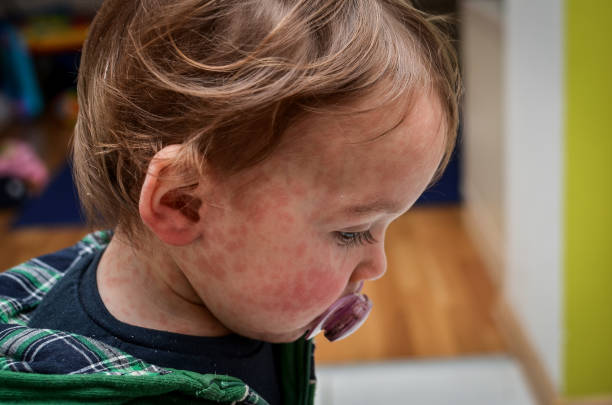2025 measles response
Exposure locations
Information about measles in Utah
As cases are reported, public health officials in Utah investigate to identify individuals who are at risk of infection and any locations where possible exposures may have occurred. These exposure locations can be found in the table above.
Measles symptoms typically appear 7 to 14 days after exposure. People who have a high fever (101°F (38.3°C) or higher) and a cough, runny nose, or red eyes may have early stages of measles. A rash will usually appear after 4 days of fever. If you do develop symptoms you should stay away from other people and call your healthcare provider. Call first before you go to a clinic or hospital to prevent other people from exposure.
Information about measles in states surrounding Utah
Measles overview

Symptoms
- High fever: Typically 101°F (38.3°C) or higher with:
- Cough
- Runny nose
- Red, watery eyes
- Rash (Measles rash usually begins as flat red spots on the face at the hairline. The spots then spread down to the neck, belly, arms, legs, and feet.)
Complications
- Pneumonia (a serious lung infection)
- Hospitalization
- Encephalitis or brain swelling (can cause cognitive disability, deafness, and seizures)
- Complications during pregnancy, such as the risk of premature labor (having your baby early), miscarriage, and your baby having a low birth weight
- Seizures
- Weakened immune system that can last weeks to years (increases the risk of bacterial infection and infection from other diseases)
- Death
When symptoms usually start (onset)
The first symptoms of measles start between 1 and 3 weeks after you are infected with the virus. Most people have symptoms at about 2 weeks.
How long it lasts (duration)
The first symptoms (fever, cough, runny nose, watery eyes) last for about 2 to 4 days but can be as short as 1 day or as long as 8 days.
The rash normally lasts 5 to 7 days and begins about 3 to 5 days after the first symptoms start.
Causes
Measles virus
How to prevent measles
- 2 doses of the MMR vaccine (measles, mumps, rubella), or
- 2 doses of the MMRV vaccine (measles, mumps, rubella, varicella)
Treatment
There's no specific treatment for a measles infection once it occurs. Treatment includes providing comfort measures to relieve symptoms, such as rest, and treating or preventing complications.
What are the vaccination rates in Utah?
Most states look at how many kindergarten students have an exemption for the measles vaccine to measure measles vaccination rates.
During the 2024/2025 school year:
- About 10% of in-person kindergarten students in Utah had an exemption for the MMR vaccine or were missing documentation to show they were vaccinated against measles.
- 9.0% of in-person kindergarten students in Utah had an exemption to any school-required vaccine.
- 10.1% of all students in Utah had an exemption to any school-required vaccine, including students in online schools.
You can look up the immunization coverage rates for children in Utah on the Utah Statistics page of the immunization program website. The immunization dashboard school vaccine exemption tab contains statewide and school-specific immunization data. You can also find reports that show trends in school vaccine exemptions for the past 10 years.
How can people who are not vaccinated protect themselves from measles?
To avoid the chance of measles infection for unvaccinated individuals we recommend the following:
- Surround yourself with other vaccinated persons, especially in your household, if possible.
- If you’re exposed to someone who has the measles, talk to a doctor about post-exposure vaccination or medication.
- Avoid large gatherings and crowded places in areas with known outbreaks and ongoing transmission.
- Consider getting the MMR vaccine at least 1 month before you try to get pregnant, to avoid harm to your baby during pregnancy.
- Stay away from others if they are sick.
If you think you or your child may have measles, we recommend you:
- Stay home and away from others as much as possible.
- Seek care if you have a hard time breathing and/or fever won’t come down.
- Call the clinic or provider ahead of time and let them know you are concerned about measles; this is to protect other people from getting exposed in the waiting area, such as pregnant women and babies.
More information about measles
- Frequently asked questions about measles (PDF)
- Measles fact sheet (English) (Spanish) (Arabic) (Dari) (Ukrainian)
Measles resources
- Prepare for and respond to measles: Checklist for summer camps (PDF)
- Prepare for and respond to measles: Checklist for K–12 schools (PDF)
- Prepare for and respond to measles: A resource for K–12 schools (PDF)
- Prepare for and respond to measles: Checklist for early care and education centers (PDF)
- Prepare for and respond to measles: Checklist for businesses (PDF)
- Prepare for and respond to measles: A resource for businesses (PDF)
Past exposure information
- On May 23, 2025, Utah DHHS was notified of someone who had measles traveled to Utah on their way to another state. Anyone who could have been exposed by this traveler was notified. There have been no reports of anyone who became infected with measles after coming into contact with this traveler.
- On June 2, 2025, Utah DHHS was notified of a second person who traveled to southwestern Utah while they were infectious with measles on May 26 and 27. While in southwestern Utah, this person visited a few public locations. Utah DHHS and local health departments are working to notify those who may have had contact with the person.
We expect to see more travelers with measles coming to Utah as measles continues to spread in the United States. Utah DHHS will continue to update this webpage with new exposure situations when they happen. Our goal is to give people the information they need to make health decisions. Vaccination continues to be the best protection against measles.


